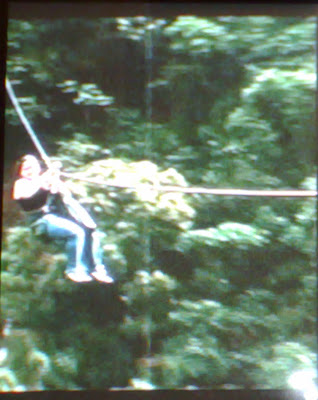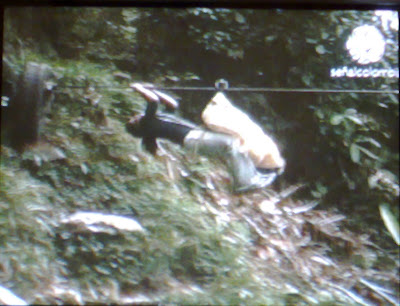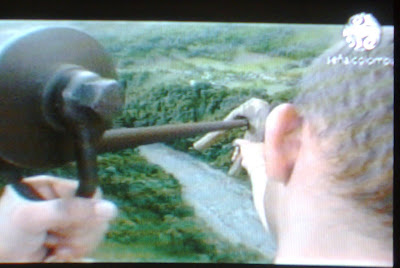In Costa Rica I had the chance to glide through the different cables belonging to several Canopy Tour outfitters in Monteverde Costa Rica. In Costa Rica, there have been many debates about who created this means of "seeing the canopy" and some people tried to copyright the idea, stating they had invented it in 1995.
With a helmet, thick padded leather gloves, a professional climbing harness and superior grade carabinners, my friends and I were sent off with plenty of instructions regarding our safety and the dire evils that would befall us were we not to pay attention to their warnings of what we shouldn´t do. We also had to sign a release form.
Today, while watching TV, on Señal Colombia I saw a special on a particular means of transportation, and wasn´t I surprised to see the Canopy zip lines! However, this is no tourist attraction, it is a means of transportation which in 30 seconds bridges the gap between two provinces: Cundinamarca and Meta, while crossing over the Negro River. The other option, by road, takes between 2 and 4 hours.

Back in 2001, this means of transportation was about to be eliminated. Some city slicker, operating on the belief that they were righting a wrong, decided that these 18 cables which have been used daily for more than 40 years (and have been maintained by community members), were a danger to society and should be eliminated. None were more surprised than the neighbors who use this cable to get to the market, to bring groceries or to take livestock from one mountain to the next. In all this time they´ve had the cable, casualties can be counted in one hand, and fingers are left over.

As one community member mentioned on the TV interview: "If this cable is to be outlawed, they should forbid airplanes, buses and cars. Imagine, if someone has an accident in this cable, one life is lost. If someone has an accident with a bus, dozens of innocent lives are lost".
The documentary took me out of my comfort zone: I saw children happily stepping into doubled up rice sacks, getting hung on a pulley and zipping across the chasm right behind their parents. The parents hang on by a rope seat each is responsible of making. They too learned how to ride the zip lines this way. First by seeing their parents load in, stepping into the sack and then zooming off. Their rite of passage is when they are old enough to go off on their own, although one mentioned that he rather likes going tandem with his father, since he gets to enjoy the view while dad does all the breaking. Breaks consist of a upside down v shape that is draped over the cable, and then brought close to the pulley when one needs to stop.

En efecto: cables como esos, llamados tarabitas, o simplemente cabuyas, han sido usados en todas las regiones de Colombia para salvar ríos o abismos desde tiempo inmemorial: figuran en infinidad de grabados de viajeros de los siglos XVIII y XIX, pero existían aun desde antes de la Conquista, cuando ni siquiera eran de acero.
As a matter of fact: cables like these, called "tarabitas" or just ropes, have been used in every Colombian region to cross rivers or chasms since time before time: they appear in countless engravings from travelers in the XVIII and XIX century, and in fact existed even before the time of Conquest, when they weren´t even made of steel.*text translated from Antonio Caballero´s article.
The cables in Guayabetal, Cundinamarca have been made by the people, hung by the people and are used by the people. Crossing is free, and everyone brings their own equipment, which is inexpensively available. People have options, and they choose this one. It is part of their culture, which they pass on to the non-initiated. A 15 year old escorts a grown woman on her first ride. Women in labor are zipped down to get them quickly to the hospital. Pigs, livestock, tree trunks and groceries are zipped back and forth. It is quick, cheap, ecological and practical. This is the one true public means of transportation for the people and by the people.
Images taken from Señal Colombia´s TV broadcast, by the old fashioned method of snapping pictures at the screen.

